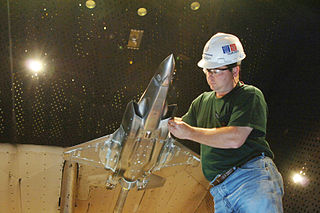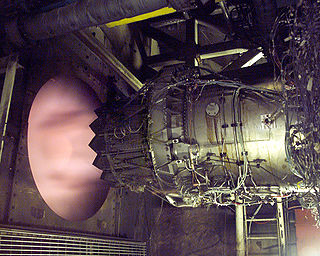External links
- company site
- US Air Force's AEDC Fact sheet regarding ATA
- Jacobs-Sverdrup ATA announcement
- CSC ATA announcement
- Nashville Business Journal
Aerospace Testing Alliance (ATA) is a defunct aerospace engineering company in the United States of America. It was the prime contractor of the US Air Force's Arnold Engineering Development Center (AEDC), in Tullahoma, Tennessee from 2003 until 2016.
Launched in 2003, ATA was a joint operation of Jacobs Sverdrup, General Physics, Computer Sciences Corporation (CSC), DynCorp. ATA was contracted at $2.7 Billion for a 12-year period.
The Center is now operated by National Aerospace Solutions

The Arnold Engineering Development Complex (AEDC), Arnold Engineering Development Center before July 2012, is an Air Force Material Command facility under the control of the Air Force Test Center (AFTC). Headquartered at Arnold Air Force Base, Tennessee, the Complex also operates from geographically separated units at Ames Research Center, Mountain View and Edwards AFB, California; Peterson AFB, Colorado; Eglin AFB, Florida; the Federal Research Center at White Oak, Maryland; Holloman AFB, Kirtland AFB, and White Sands Missile Range, New Mexico; Wright-Patterson AFB, Ohio, and Hill AFB, Utah. AEDC operates more than 68 test facilities, including, but not limited to, aerodynamic and propulsion wind tunnels, rocket and turbine engine test cells, environmental chambers, arc heaters, ballistic ranges, sled tracks, centrifuges, and other specialized test units.
The University of Tennessee Space Institute, also known as UTSI, is a satellite campus of the University of Tennessee located near Tullahoma, Tennessee.

Arnold Air Force Base is a United States Air Force base located in Coffee and Franklin counties, Tennessee, adjacent to the city of Tullahoma. It is named for General Henry "Hap" Arnold, the father of the U.S. Air Force.
The Aerospace Corporation is an American California nonprofit corporation that operates a federally funded research and development center (FFRDC) headquartered in El Segundo, California. The corporation provides technical guidance and advice on all aspects of space missions to military, civil, and commercial customers. As the FFRDC for national-security space, Aerospace works closely with organizations such as the United States Air Force Space and Missile Systems Center (SMC) and the National Reconnaissance Office (NRO) to provide "objective technical analyses and assessments for space programs that serve the national interest". Although SMC and NRO are the primary customers, Aerospace also performs work for civil agencies as well as international organizations and governments in the national interest.

Leif Johan Sverdrup was a Norwegian-born American civil engineer and general with the U.S. Army Corps of Engineers in the first half of the 20th century. He is best known for his service in the Southwest Pacific Area during World War II where he was Chief Engineer under General of the Army Douglas MacArthur.

Sverdrup & Parcel was an American civil engineering company formed in 1928 by Leif J. Sverdrup and his college engineering professor John I. Parcel. The company worked primarily in a specialty field of bridges. The company's headquarters was located in St. Louis, Missouri.
The Scientific Advisory Group of the United States Air Force, later renamed the Scientific Advisory Board, was established in 1944, when General Henry H. Arnold asked Dr. Theodore von Kármán to establish a group of scientists to review the techniques and research trends in aeronautics. The group was asked to evaluate the aeronautical research and development programs and facilities of the Axis powers of World War II, and to provide recommendations for future United States Air Force research and development programs.

The 253d Cyberspace Engineering Installation Group is located at Otis Air National Guard Base, Massachusetts, USA.
The George M. Low Award is an annual award given by NASA to its subcontractors in recognition of quality and performance. NASA characterizes it as a "premier award". NASA's chief of safety and mission assurance, Terrence Wilcutt, called it "our recognition for their management's leadership and employee commitment to the highest standards in performance."

AEDC Range G is a two-stage light-gas gun owned by the United States Air Force.

The 19th Space Operations Squadron is an Air Force Reserve space operations unit, located at Schriever Air Force Base, Colorado.
AEDC Ballistic Range S-3 is a single stage air gun owned by the United States Air Force. The gun is commonly used for bird strike testing and is often called a chicken gun.

Lufkin Air Force Station is a closed United States Air Force General Surveillance Radar station. It is located 7.2 miles (11.6 km) northwest of Lufkin, Texas. It was closed in 1961.
Willow Run Air Force Station is a former United States Air Force station that operated to the east of Willow Run Airport in Michigan.

Oklahoma City Air Force Station is a closed Cold War United States Air Force air defense and communications-electronics headquarters and radar station. It was located 10 miles (16 km) east-southeast of Oklahoma City, Oklahoma, just to the southeast of Tinker Air Force Base. It ceased to be a separate Air Force installation on 1 October 1983, when it merged with Tinker.

AEDC Aerodynamic and Propulsion Test Unit (APTU) is a blowdown hypersonic wind tunnel driven by a combustion air heater (CAH). The facility is owned by the United States Air Force and operated by Aerospace Testing Alliance.

AEDC Hypervelocity Wind Tunnel 9 is a hypersonic wind tunnel owned by the United States Air Force and operated by National Aerospace Solutions The facility can generate high Mach numbers and high Reynolds for hypersonic ground testing and the validation of computational simulations for the Air Force and Department of Defense.
The AEDC Sea Level Test Cells, located at Arnold Engineering Development Complex, is a collection of test cells used to economically perform durability testing on large augmented turbine engines at near sea level conditions. All test units in the facility are owned by the United States Air Force and currently operated by National Aerospace Solutions.

The People's Liberation Army Strategic Support Force is the cyber-, space-, and electronic-warfare service branch of China's People's Liberation Army. It was established in December 2015 as part of the first wave of the Chinese military reforms.
Leon Stanislaw Jablecki was an American rocket scientist.